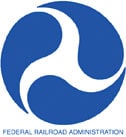
The central concern in each situation is whether the practice violates the prohibition in the Railroad Operating Practices regulations at 49 CFR 218.99(b), which states, in part:
No unrelated tasks. During the shoving or pushing movement, the employee directing the movement shall not engage in any task unrelated to the oversight of the shoving or pushing movement.
Factual circumstances may dictate whether an operation is safe and in compliance with the regulations.
Question 1: Do the Railroad Operating Practices regulations allow an employee to make an initial determination that the track is clear from a motor vehicle in which the employee is operating prior to the initiation of the shoving or pushing movement?
Answer: While there may be some risk involved when an employee is both determining that the track is clear and operating the motor vehicle, the regulation does not strictly prohibit the same person from doing these tasks simultaneously when the movement has not been initiated and oversight of the movement is not required. However, if the terrain is uneven or the view is obstructed, the person may occasionally have to operate the vehicle at a slower speed or even stop the vehicle in order to accurately determine that the track is clear.
Question 2: Do the Railroad Operating Practices regulations allow an employee to determine that the track is clear from a motor vehicle in which the employee is operating while simultaneously directing a shoving or pushing movement that is in motion?
Answer: Although there is no strict prohibition, the FRA is concerned that an employee who operates a motor vehicle while the shoving or pushing movement is in motion may not be adequately overseeing the train movement.
One of the stated purposes of the prohibition against engaging in any task unrelated to the oversight of the shoving or pushing movement was that it “increases the probability that the controlling employee will be in a position to reduce the severity of any accident that might occur.” (73 Fed. Reg. 8442, 8476) The cited language in the preamble to the rule immediately follows a recap of the fatal accident in Manlius, N.Y., which led to the issuance of FRA Safety Advisory 2007-01.
That fatal accident involved a carman whose vehicle was dragged a considerable distance before the employee directing the movement was contacted to stop the movement. The preamble language clarified that the “no unrelated task” provision was added as a compromise in exchange for the FRA giving up the proposed requirement that the leading end of the movement be continuously kept in sight by the employee directing the movement.
The FRA recognized that “a ‘continuous observation’ requirement would force more employees either to walk or ride the point – creating an even greater vulnerability that someone could get hurt.” (73 Fed. Reg. 8476) The same type of argument could be made regarding an employee directing the movement who is instructed or elects to drive a vehicle while the shoving or pushing movement is in motion.
With these concerns in mind, the FRA determined that an employee must not simultaneously direct a shoving or pushing movement while operating a motor vehicle of any type, except as follows:
* An employee may operate a motor vehicle to a point where he or she can visually determine that the track is clear, pursuant to 49 CFR 18.99(b)(3)(i). After stopping the motor vehicle and determining that the track is clear for a specified distance, the employee directing a shoving or pushing movement may give an initial instruction to the engineer to start a shoving or pushing movement for the specified distance.
* After giving the initial instruction, the employee may operate the motor vehicle while the shoving or pushing movement is in motion.
* After visually determining that the track is clear for an additional specified distance, the employee directing a shoving or pushing movement must stop the motor vehicle in order to provide any additional instructions to the engineer. This process may be repeated until the shoving or pushing movement is completed.
* The FRA recognizes “that employees can safely make shoving or pushing movements without continuously observing the leading car (i.e., the leading end of the movement) for the entire distance of the movement.” (73 Fed. Reg. 8477) However, to the extent possible, the FRA would expect an employee to observe a shoving or pushing movement in progress and be able to take appropriate action to minimize the severity of any unexpected derailment or accident that might occur.
* Under all circumstances, the engineer must stop the movement in one-half the specified distance, unless additional instructions are received. (49 CFR 220.49)
Question 3: Do the Railroad Operating Practices regulations allow an employee directing the shoving or pushing movement that is in motion to determine that the track is clear while riding in a motor vehicle as a passenger?
Answer: There is no strict prohibition on an employee determining that the track is clear while riding in a motor vehicle as a passenger. Of course, if the terrain is uneven or the view is obstructed, it may not be factually possible to make the determination that the track is clear. As always, the FRA will consider enforcement action when the circumstances show that the person could not make an accurate determination.